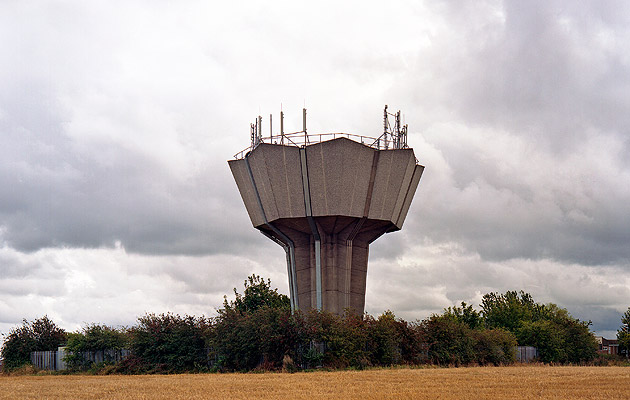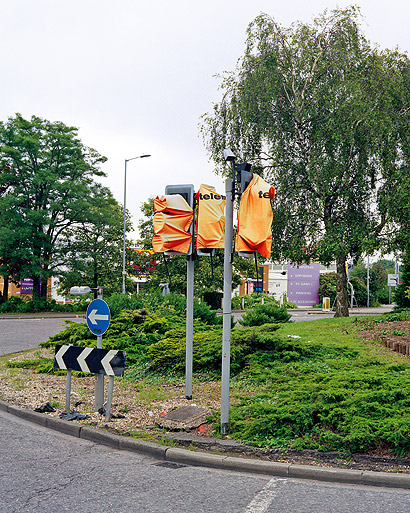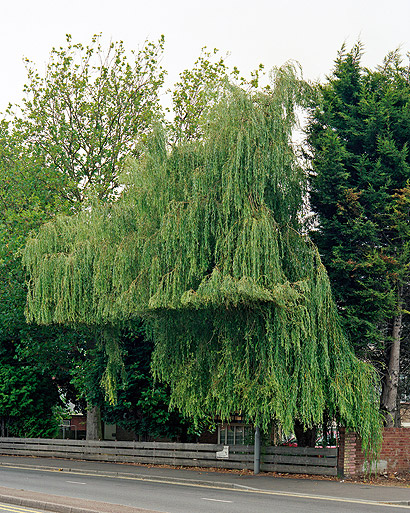|
Water Tower (image: James Smith) |
||
|
Two sets of photographs – one by an outsider, another by locals – highlights Luton’s sense of loss and abandonment, says Owen Hatherley Few art galleries can advertise themselves as being “above Betfred”, as does Luton’s Departure Lounge gallery – though the location is apt. The walk from station to gallery takes in a vast shopping mall, which swallows up about half of a miniscule town centre. Outside that is an expanse taking in “London Luton Airport”, hence the gallery’s droll name. Luton has a quality of misery that only the southern English industrial town can really muster, uninterested in emulating the civic grandeur of its northern cousins. So it’s the perfect place for a revisionist photographic exhibition on the south-east’s modern spaces. Luton Overlay is part of London Overspill, a series by photographer James Smith on the new or expanded southern towns, later to take in the relatively sylvan Stevenage and Peterborough. The territory surveyed here delineates how, beyond the Green Belt, London kept growing, starting up again where the belt stopped. Luton Overlay is combined with From the Shoebox, which asks Lutonians to send in their own photographs of the area’s modernist buildings, making for a potentially sharp juxtaposition, where the eye of the aesthete meets the eye of the resident. Will they see the same things? Smith’s photographs, the flyer promises, “will be unfamiliar even to people who have lived in Luton all their lives”, and unfortunately it’s hard not to worry that Departure Lounge may be too. It shares with the salubrious bookmaker a very fine 1930s Streamline moderne building, with the show’s title advertised to lure the shoppers and evangelists below. But to get in, you have to ring a bell round the back. I was the only visitor, on a Saturday afternoon. Inside, Smith’s architectural details and some carefully chosen urban-pastoral scenes are spaciously laid out in an airy, Crittall-windowed space; the “shoebox” stuff is in corridors. Smith’s photographs don’t flatter Luton exactly, but reveal an easily overlooked strangeness, usually in its suburbs – clipped, ordered post-war houses and heavy underpasses interacting with nature, alternately violently and neatly. Close-ups on details, such as walkways traversing undergrowth or the pop-art mosaics on a lonely pilot, are proof that some elegance can be found even in Luton, if you stare at it hard enough. Yet mostly, they have a tense, uneasy quality, documenting a half-hearted modernism. The selection carefully avoids Luton’s most famous and/or notorious modern buildings – the immense megastructure of the shopping centre, and the swathe of detritus left by the Vauxhall Motors factory complex in the suburbs. These are, unsurprisingly, the focus of the photos given in by the local residents. They’re an odd bunch, and at least half are not even of Luton – a lot of space is taken up by artsy close-ups of the more confident modernity of Milton Keynes and there are several archival snapshots from the University of Hertfordshire, in Hatfield. Other photos are of art deco cinemas (snapped when they were actually showing films); a rather more glamorous model of quotidian modernism than that of assembly lines and shopping malls. Vauxhall Motors dominates, largely in blueprints and photos of its slick, 1980s late modernist office block. A sense of loss is implicit in Smith’s depopulated photos, but here it’s clear indeed. The eventual result of this meeting of eyes – trained and untrained – is ambiguous. Maybe once people cared enough to try and design decent buildings here; they certainly don’t now. The photographer lingers on a concrete walkway, the visitor on a faïence facade, but those in the planes descending overhead will seldom see either.
Light Covers (image: James Smith)
Mature Tree (image: James Smith) Luton Overlay, Part of London Overspill by James Smith and UH Galleries, Various Locations in 2013 |
Words Owen Hatherley |
|
|
||




















